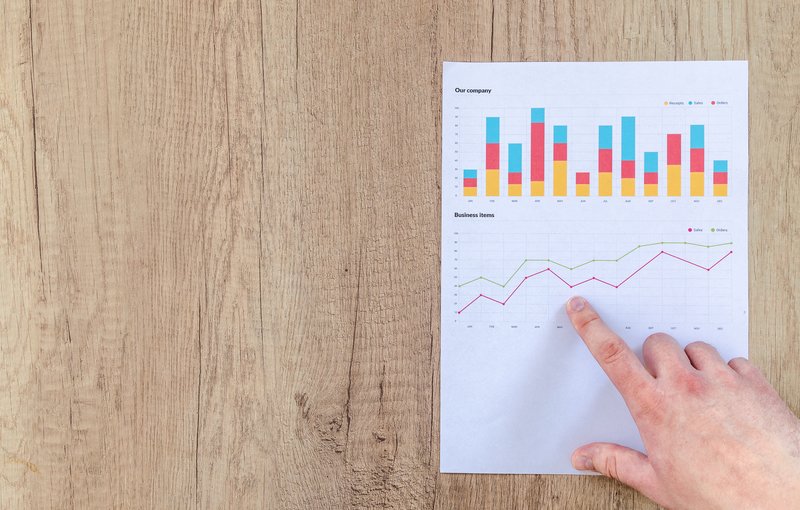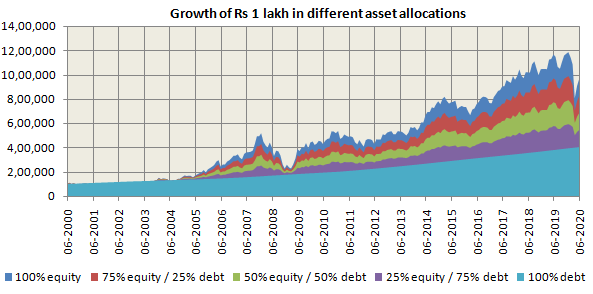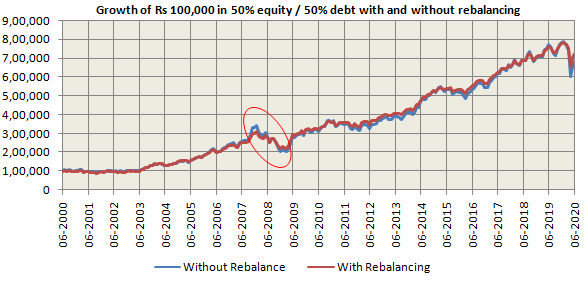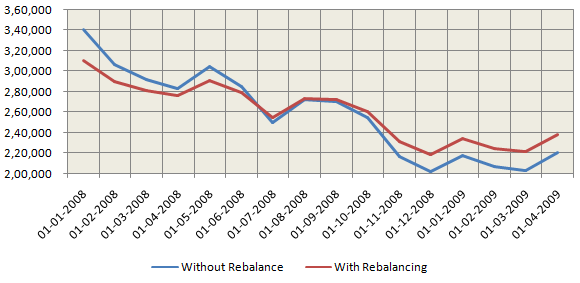Asset allocation in difficult times

What is Asset Allocation?
Asset allocation is diversifying your investment into assets of different risk classes e.g. equity, debt, gold etc. Equity as an asset class can grow your wealth over a long investment horizon, whereas debt provides stability and generates income for you. Gold as an asset class is usually counter-cyclical to equity and a long term hedge against inflation. An optimal mix of two or more asset classes will balance risk and return.
Asset allocation depends on risk appetite
Different investors have different risk appetites depending on their stage of life and financial circumstances (e.g. savings, loans etc). For example, a younger investor who is in the accumulation stage of life can be more overweight on equity compared to an investor who is approaching retirement. A retiree investor, who depends on income from his investments, is likely to be overweight on debt. Once you determine your asset allocation based on risk appetite you should be disciplined in maintaining it irrespective of market situation.
Asset allocation and portfolio volatility
Asset allocation has a direct impact on portfolio volatility. Equity market always works in cycles – period of rising prices (bull market) will always be followed by period of falling prices (bear market). However, historical data shows that equity outperforms debt in the long term. In the chart below, we have shown the growth of Rs 1 lakh investment in different asset allocation in the last 20 years (ending 1st June 2020). Here we have used Nifty 50 TRI as the proxy for equity and 1 year bank Fixed Deposit (renewed yearly) as proxy for debt.

Source: National Stock Exchange, Advisorkhoj Research
You can see that while higher weight to equity in asset allocation leads to higher potential of wealth creation, it can lead to larger drawdowns (fall from peak to bottom). Therefore, you should always invest according to your risk appetite.

Source: Advisorkhoj Research
Asset Allocation Rebalancing
In bull markets, equity grows much faster than debt and vice versa in bear markets. As a result, your asset allocation can deviate substantially from your target causing an imbalance and potentially harmingyour financial interests. You must rebalance your asset allocation regularly to bring it back to target, e.g. if your target asset allocation is 50% equity / 50% debt your current asset allocation is 60% equity / 40% debt then you should switch a portion of your equity assetsto debt, if your current asset allocation is 40% equity / 60% debt then you should switch from debt to equity.
The chart below shows the growth of Rs 100,000 investment 50% equity (with Nifty 50 TRI as proxy) and 50% debt(bank FD as proxy) asset allocation without rebalancing and with monthly rebalancing over the last 20 years (ending 1st June 2020). Without rebalancing your investment would have grown to Rs 6.82 lakhs, while with rebalancing your investment would have grown to Rs 7.24 lakhs. The maximum drawdown without rebalancing was Rs 137,225 while with rebalancing it was just Rs 91,241.

Source: National Stock Exchange, Advisorkhoj Research
Asset rebalancing in volatile markets
Rebalancing is essentially about buying low and selling high. Volatile markets call for a more active rebalancing because asset allocation can change very quickly in volatile conditions. You should be proactive in maintaining your target asset allocation so that you are able to meet your long term financial goals. There are no hard and fast rules regarding how often you should rebalance, but financial planners suggest rebalancing when prices have fallen 15 - 20%. The chart below shows how active rebalancing discussed in the previous section worked during the global financial crisis of 2008 (region in the chart above circled in red).

Source: National Stock Exchange, Advisorkhoj Research
Summary
Most of us are guided by emotions like greed and fear in investing. Emotions are heightened in difficult markets like we saw in 2008 global financial crisis or the ongoing COVID-19 crisis. But panic will harm your long term financial interests. Research has shown that asset allocation, not market timing, is the most important attribution factor of portfolio performance. Asset allocation and regular rebalancing is simply disciplined way of investing especially in difficult market conditions. You should consult with your financial advisor if you need help with your asset allocation.
Mutual Fund Investments are subject to market risk, read all scheme related documents carefully.
#Wise With Edelweiss – An Investor Education Initiative by Edelweiss Mutual Fund.
EAML is amongst the fastest growing asset management companies, being an asset management subsidiary of Edelweiss Financial Services Ltd., one of Indias leading financial services group since last 21 years with a proven track record of quality and innovation. Edelweiss AML is present across 11 locations across the country. EAML offers a suite of differentiated asset management products and the unique knowledge proposition focusing on building a strong connect with Distributors and customers. At Edelweiss AMC, the aim is to come up with truly innovative ideas that doesnt exist today and bridge the gap between what investors want and what the industry has to offer.
Quick Links
Contact Us
- Toll Free : 1800 425 0090
- Non Toll Free : +91-40-23001181
- EMFHelp@edelweissfin.com
- distributor.amc@edelweissfin.com
POST A QUERY





